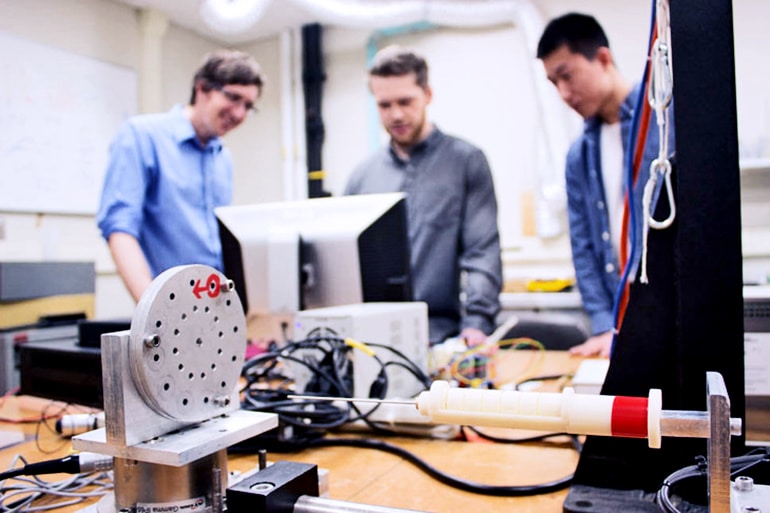Researchers have created a new low-cost needle-insertion simulator that can help doctors improve their technique and dexterity.
Administering needle procedures like epidurals can be difficult for even seasoned doctors. Current training methods are costly and fall short in preparing doctors for every patient and situation they might face, researchers say.
The new haptic-force needle-insertion simulator is a hand-held device that simulates the tactic feeling of the instrument passing through several layers of tissue. It also connects to a computer program that can assess the user’s performance.
These factors are crucial because the doctor’s hands need to produce a steady rate of insertion, which can be challenging.

“There’s a buildup of force upon tissue deflection and a sudden release of force upon tissue puncture,” says Jason Moore, associate professor of mechanical engineering at Penn State. “This training tool can help surgeons, residents, and med students improve their dexterous abilities.”
Working in harmony, the tool and program interface will provide real-time feedback on the physician’s performance during training. This response is crucial to the device and represents a new efficiency and effectiveness of surgical training.
Currently, the most effective way to train clinicians is to observe other doctors.
“Those of us who teach these procedures find it very difficult to teach the needle, eye, and image coordination skills,” says Sanjib Adhikary, associate professor of anesthesiology, and coinvestigator of the project. Using the simulator, doctors will be better prepared for these procedures.
“It can raise the ability of residents before they begin performing these procedures on patients,” Moore says. “It also gives them a very nice way to assess their performance and understand where improvements can be made.”
Current training methods, like using mannequins, are more expensive and don’t account for the range of body types a doctor would encounter in their patients. The new device is able to change its simulation based on different scenarios, like varying skin thickness and excess body weight.
“Being unprepared for diverse patient scenarios can increase the probability of complications occurring, and this training will help the doctor’s ability to adapt,” Moore says.
Body for practice surgery even bleeds fake blood
Eventually, the tool could be adapted to train doctors in other specialties like emergency medicine, radiology, and surgery.
“This project has the potential to revolutionize training on surgical procedures,” says Scarlett Miller, associate professor of engineering design and industrial engineering.
The researchers are confident their device will make an impact, especially as it represents a low-cost method to this common problem.
“We’re really excited because the device is slated be relatively low cost, less than $100,” Moore says. “I would love to see this widely applied, all the way down to undergraduate pre-med programs. It could be impactful to easily assess this skill and provide meaningful feedback to allow for continuous improvement.”
Armband trains nurses to implant birth control
Moore, Adhikary, and Miller recently received an ENGINE grant from the College of Engineering to commercialize the product. The team hopes to test the device and receive feedback from physicians next fall.
“This project not only has the potential for commercial value, but also for helping save human lives,” Miller says.
Source: Penn State



